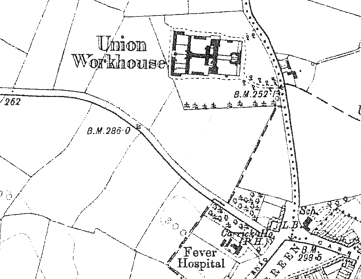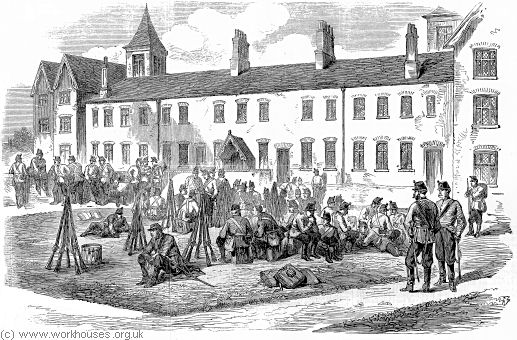Kells, Co. Meath
Kells Poor Law Union was formally declared on the 8th July 1839 and covered an area of 178 square miles. Its operation was overseen by an elected Board of Guardians, 24 in number, representing its 13 electoral divisions as listed below (figures in brackets indicate numbers of Guardians if more than one):
Co. Meath: Burry (2), Dulane (2), Felltown, Girley, Kells (3), Kilbeg (2), Kilmainham, Kilskeer (2), Moynalty (2), Nobber (2), Rathmore (2).
Co. Cavan: Mullagh (2).
Co. Westmeath: Clonmellon (2).
The Board also included 8 ex-officio Guardians, making a total of 32. The Guardians met each week at noon on Saturday.
The population falling within the Union at the 1831 census had been 40,497 with divisions ranging in size from Felltown (population 1,308) to Kells itself (6,839).
The new Kells Union workhouse was erected in 1840-1 on a nine-acre site to the north-west of Kells. Designed by the Poor Law Commissioners' architect George Wilkinson, the building was based on one of his standard plans to accommodate 600 inmates. Its construction cost £5,970 plus £939 for fittings etc. The workhouse was declared fit for the reception of paupers on 25th April 1842, and received its first admissions on 23rd May. The site location and layout are shown on the 1912 OS map below.

Kells workhouse site, 1912.
The buildings followed Wilkinson's typical layout. An entrance and administrative block at the east contained a porter's room and waiting room at the centre with the Guardians' board room on the first floor above.
The main accommodation block had the Master's quarters at the centre, with male and female wings to each side. At the rear, a range of single-storey utility rooms such as bakehouse and washhouse connected through to the infirmary and idiots' wards via a central spine containing the chapel and dining-hall.
During the famine in the mid-1840s, sheds attached to the idiot wards were enclosed and adapted to accommodate 200 extra inmates. The workhouse did not have its own fever hospital but sent fever patients to the nearby fever hospital in Kells.
In 1870, there was a spate of civil unrest in the Meath area caused by the Duke of Leinster's attempts to evict Irish tenants from his properties and to replace them with English ones. At the end of March 1870, a detachment of troops was sent to Kells to try and keep the peace. When they arrived, arrangements for their accommodation had not been completed and they were obliged to camp temporarily at the union workhouse.

Troops at Kells workhouse, 1870.
The workhouse buildings were demolished in the 1960s.
Records
Note: many repositories impose a closure period of up to 100 years for records identifying individuals. Before travelling a long distance, always check that the records you want to consult will be available.
- Meath County Library, Railway Street, Navan, Co. Meath. Holdings: Guardians' Minute Books (Aug 1839 - Aug 1872, Feb 1873 - Jun 1922); Rough Minute Books (Oct 1881 - Oct 1882, Apr 1902 - Oct 1911).
Bibliography
- Crossman, V (2006) Politics, Pauperism and Power in Late Nineteenth-century Ireland
- Gray, P (2009) The Making of the Irish Poor Law, 1815-43
- O'Connor, J (1995) The Workhouses of Ireland
Links
- None.
Unless otherwise indicated, this page () is copyright Peter Higginbotham. Contents may not be reproduced without permission.


